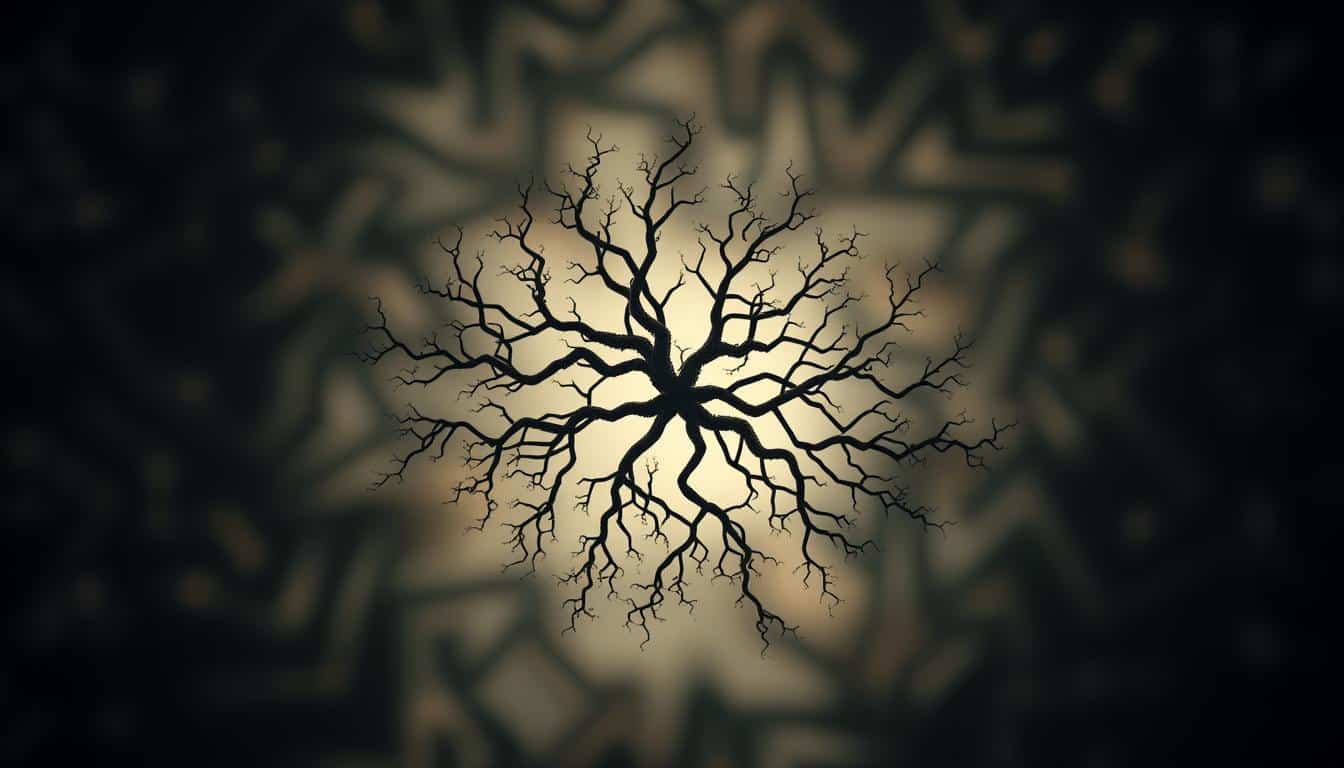How humans view time greatly varies across different cultures. In Western societies, people often see time as Linear Time. It’s like a straight line that moves towards progress and success. This view highlights the importance of individual goals and looking forward to the future.
On the other side, many Eastern cultures view time as Circular Time. They see it as a continuous cycle linked to natural patterns and life’s repetitive cycles. This way of seeing time deeply affects how these cultures understand their history, keep traditions alive, and connect with nature. Knowing about these Cultural Perspectives helps us grasp the varied ways people around the world experience time.
The Conceptualization of Time in Different Cultures
Time is more than just clocks and calendars. It’s tied to who we are culturally. Around the world, the way people see time can vary a lot. This impacts how societies function and how people connect with each other. In the West, people often view time as a straight line. This idea comes from Judeo-Christian beliefs. It makes us think of each moment as unique and unrepeatable.
In the East, the view on time is quite different. Here, time is seen as a cycle that repeats. This view reflects the natural world and its seasons. It suggests things are linked and happen over and over, not just in a straight line. How cultures measure time can affect how people act socially, too.
- Punctuality and Time Management: Western cultures see being on time as important. It shows respect and professional behavior.
- Leisure and Flexibility: Eastern cultures may value taking it easy and being flexible more. This leads to a chilled approach to time.
- Generational Views: Inside a culture, old and young people might view time differently. Seniors might stick to old ways, while the young try new things.

Linear Time: A Progressive Perspective
Linear time moves us from one moment to another, always heading towards the future. It’s a key part of Western culture’s view on life. Here, big achievements mark important points in our journey, showing us that hard work and new ideas can lead to success.
The Cultural Values of Time shape how we see time moving straight forward. This view makes us eager to chase what’s next, without looking back. It tells us every moment is a chance we won’t get again, pushing us to be productive. As tech and science leap forward, we see time as a force that never stops.
Time is seen as a chance to grow, both personally and as a society. The idea of Linear Time Definition highlights moving ahead, different from cycles that repeat. Adopting this view of progress tells us to grab each day and explore its chances.
Characteristics of Linear Time
Linear time has three key features that shape how we see and use it. Each trait makes us see time as moving in one direction. This idea affects how we do things and see the world around us.
- Irreversibility of Moments: Time keeps moving forward, never going back. Once a moment is gone, it’s lost forever. This makes us focus on moving towards the future, leaving the past behind.
- Progressive Nature of Events: In linear time, events happen one after another. This is clear in how technology and industries grow. Each step forward builds on what came before, showing progress and change.
- Objective Measurement of Time: Linear time doesn’t change based on how we feel. We use clocks and calendars to measure time accurately. This helps everyone stay organized and plan their days better.
Cyclical Time: Embracing Repetition and Patterns
The Cyclical Time Definition talks about events repeating themselves and recognizable patterns showing up. This idea goes against linear time, showing the value of natural cycles. Cultures like the Maya and those in Hinduism see time through solar and lunar cycles. They understand life as a series of repeating events.
Many communities see the importance of Time as a Cycle in farming and spiritual rituals. Farmers time their planting and harvesting with the seasons. They have festivals during certain lunar phases, showing a connection with nature’s rhythms.
Cultural habits highlight the value of noticing Patterns in Nature. Belief in reincarnation is one way to see life’s ongoing nature. This view helps people see their lives as part of a larger cycle, not just a straight path. It lets them connect deeply with time and nature, helping them stay strong through life’s challenges.
Historicity and Cultural Significance of Cyclical Time
The idea of cyclical time is ancient and widespread. Many Ancient Civilizations, like the Mayans and Egyptians, followed nature’s rhythms closely. They created calendars based on the sky and seasons. These weren’t just for keeping track of days. They also guided farming and religious rituals, showing how everything in life is connected.
Seasonal events were crucial in these old societies. Festivals marked the changing seasons, celebrating the circle of life. The Mayan calendar, for example, had many cycles. These helped them know the best times for planting and harvesting crops.
This way of seeing time brought these communities closer to nature. Celebrations and traditions helped keep society together. They did more than entertain; they built connections among people and with the environment. Thus, the cyclical calendars had a deep meaning, reinforcing unity and harmony.
Comparative Analysis: Circular Time vs. Linear Time: Connection to Natural Patterns
The way we see time as circular or linear changes how we feel and act. Linear time focuses on milestones and goals. It moves us forward, always looking to the next big thing.
On the other hand, circular time links us to nature’s rhythms. It’s about renewal and coming back to what we know. This view helps us see how we’re part of bigger cycles, like the changing seasons.
These views on time affect how societies work and how people act. Cultures with a linear view may chase after success and quick results. Those who see time as circular value balance and living in harmony. By understanding these perspectives, we can better navigate life and connect with others.
Philosophical Implications of Time Perception
Philosophical thoughts on time shape how we see life. Time mixes with our existence, making every moment important. Looking at time as a line, we see our journey from past to future. This view makes us think about our choices and plans. It suggests that what we decide influences our life’s path and milestones.
The idea of time being cyclical is another interesting path. It focuses on renewal and constant learning. This concept suggests life has repeating patterns. It lets us see challenges as chances to grow, not fail. By adopting this mindset, we can deeper understand our growth. We learn to value lessons from the past as much as future goals.
Personal Experience and Psychological Factors in Time Perception
Time Perception Psychology shows us how our own experiences shape the way we see time. As we get older, we notice big changes in how we perceive time, especially when we think about aging. Studies show that as people age, they often feel like time speeds up. This feeling mainly comes from having fewer new experiences, making it seem like time flies faster.
Several psychological factors play a role in this. Some of the main ones are:
- Stress levels: High stress can make time seem to stretch or shrink.
- Anxiety: Feeling anxious can make us feel rushed, changing our sense of time.
- Routine: Doing the same things every day can make it harder to remember specific moments, making time seem to go quicker.
Being more aware of these factors can teach us a lot about our behavior, productivity, and happiness. Knowing how aging and time are connected through psychology helps us handle our experiences and perceptions better. This can lead to better well-being.
Finding Balance: Integrating Linear and Circular Perspectives
To deeply understand time, we must value both linear and circular views. Linear perspectives focus on moving forward and achieving goals. This can make us feel successful, but it might also cause stress and burnout.
Meanwhile, a circular view highlights the importance of rest and growing as a person. It respects life’s natural flows, making room for recovery. Balancing these ideas is key for true happiness.
Combining these perspectives, we can nurture a balanced approach to time. This way, we chase our dreams but also care for ourselves. Such a balance leads to a joyful and lasting lifestyle.
Conclusion
We’ve explored the concept of time, looking at the ideas of circular and linear time. Each idea affects how people see the world and live their lives. Knowing about both can help us understand the rich, complex idea of time and its role in our lives.
Thinking about time can help us grow and understand life’s cycles better. These cycles and our goals often exist together. This helps us connect with life’s rhythms. We can appreciate our progress and the value of repeated experiences.
Using ideas from both circular and linear time can make us value life more. This approach helps us deal with time’s challenges in a balanced way. The mix of circular and linear time encourages us to live fully, remembering the past and future.



